Inequalities in Exposure to Nitrogen Dioxide in Parks and Playgrounds in Greater London
Abstract
1. Introduction
2. Materials and Methods
2.1. Open Spaces Data
2.2. NO2 Concentrations
2.3. Socioeconomic Deprivation
2.4. Child Residential Proximity to Play Spaces
2.5. Statistical Analysis
3. Results
3.1. Average NO2 Concentrations in Open Spaces
3.2. Inequalities in Children’s Exposure at Play Spaces
4. Discussion
4.1. Key Results
4.2. Policy Implications
4.3. Strengths and Limitations
5. Conclusions
Author Contributions
Funding
Acknowledgments
Conflicts of Interest
References
- Committee on the Medical Effects of Air Pollutants. Associations of Long-Term Average Concentrations of Nitrogen Dioxide with Mortality; Public Health England: London, UK, 2018. [Google Scholar]
- Urman, R.; McConnell, R.; Islam, T.; Avol, E.L.; Lurmann, F.W.; Vora, H.; Linn, W.S.; Rappaport, E.B.; Gilliland, F.D.; Gauderman, W.J. Associations of children’s lung function with ambient air pollution: Joint effects of regional and near-roadway pollutants. Thorax 2014, 69, 540–547. [Google Scholar] [CrossRef] [PubMed]
- Bowatte, G.; Lodge, C.; Lowe, A.J.; Erbas, B.; Perret, J.; Abramson, M.J.; Matheson, M.; Dharmage, S.C. The influence of childhood traffic-related air pollution exposure on asthma, allergy and sensitization: A systematic review and a meta-analysis of birth cohort studies. Allergy 2015, 70, 245–256. [Google Scholar] [CrossRef] [PubMed]
- Bloemsma, L.D.; Wijga, A.H.; Klompmaker, J.O.; Janssen, N.A.; Smit, H.A.; Koppelman, G.H.; Brunekreef, B.; Lebret, E.; Hoek, G.; Gehring, U. The associations of air pollution, traffic noise and green space with overweight throughout childhood: The PIAMA birth cohort study. Environ. Res. 2018, 169, 348–356. [Google Scholar] [CrossRef] [PubMed]
- Alvarez-Pedrerol, M.; Rivas, I.; López-Vicente, M.; Suades-González, E.; Donaire-Gonzalez, D.; Cirach, M.; de Castro, M.; Esnaola, M.; Basagaña, X.; Dadvand, P.; et al. Impact of commuting exposure to traffic-related air pollution on cognitive development in children walking to school. Environ. Pollut. 2017, 231, 837–844. [Google Scholar] [CrossRef] [PubMed]
- Mudway, I.S.; Dundas, I.; Wood, H.E.; Marlin, N.; Jamaludin, J.B.; Bremner, S.A.; Cross, L.; Grieve, A.; Nanzer, A.; Barratt, B.M.; et al. Impact of London’s low emission zone on air quality and children’s respiratory health: A sequential annual cross-sectional study. Lancet Public Health 2019, 4, e28–e40. [Google Scholar] [CrossRef]
- Knibbs, L.D.; de Waterman, A.M.C.; Toelle, B.G.; Guo, Y.; Denison, L.; Jalaludin, B.; Marks, G.B.; Williams, G.M. The Australian Child Health and Air Pollution Study (ACHAPS): A national population-based cross-sectional study of long-term exposure to outdoor air pollution, asthma, and lung function. Environ. Int. 2018, 120, 394–403. [Google Scholar] [CrossRef] [PubMed]
- Gauderman, W.J.; Avol, E.; Gilliland, F.; Vora, H.; Thomas, D.; Berhane, K.; McConnell, R.; Kuenzli, N.; Lurmann, F.; Rappaport, E.; et al. The effect of air pollution on lung development from 10 to 18 years of age. N. Engl. J. Med. 2004, 351, 1057–1067. [Google Scholar] [CrossRef] [PubMed]
- Joint Air Quality Unit. Improving Air Quality in the UK: Tackling Nitrogen Dioxide in Our Towns and Cities; Department for Environment Food & Rural Affairs and Department for Transport: London, UK, 2017.
- World Health Organization. WHO Air Quality Guidelines for Particulate Matter, Ozone, Nitrogen Dioxide and Sulfur Dioxide: Global Update 2005; WHO: Geneva, Switzerland, 2006. [Google Scholar]
- Department for Environment Food & Rural Affairs. Local Air Quality Management: Policy Guidance; Department for Environment Food & Rural Affairs: London, UK, 2016.
- Pimpin, L.; Retat, L.; Fecht, D.; de Preux, L.; Sassi, F.; Gulliver, J.; Belloni, A.; Ferguson, B.; Corbould, E.; Jaccard, A.; et al. Estimating the costs of air pollution to the National Health Service and social care: An assessment and forecast up to 2035. PLoS Med. 2018, 15, e1002602. [Google Scholar] [CrossRef] [PubMed]
- Mittal, L.; Fuller, G. London Air Quality Network: Summary Report 2016; King’s College London: London, UK, 2017. [Google Scholar]
- Brook, R.; King, K. Updated Analysis of Air Pollution Exposure in London; Aether Ltd.: Oxford, UK, 2017. [Google Scholar]
- WSP. The Mayor’s School Air Quality Audit; Greater London Authority: London, UK, 2018.
- Unearthed. More than 1000 Nurseries Nationawide Close to Illegally Polluted Roads. Available online: https://energydesk.greenpeace.org/2017/04/04/air-pollution-nurseries/ (accessed on 29 July 2019).
- Meier, R.; Eeftens, M.; Phuleria, H.C.; Ineichen, A.; Corradi, E.; Davey, M.; Fierz, M.; Ducret-Stich, R.E.; Aguilera, I.; Schindler, C.; et al. Differences in indoor versus outdoor concentrations of ultrafine particles, PM2.5, PMabsorbance and NO2 in Swiss homes. J. Expo. Sci. Environ. Epidemiol. 2015, 25, 499–505. [Google Scholar] [CrossRef] [PubMed]
- Tainio, M.; de Nazelle, A.J.; Götschi, T.; Kahlmeier, S.; Rojas-Rueda, D.; Nieuwenhuijsen, M.J.; de Sá, T.H.; Kelly, P.; Woodcock, J. Can air pollution negate the health benefits of cycling and walking? Prev. Med. 2016, 87, 233–236. [Google Scholar] [CrossRef] [PubMed]
- Fisher, J.E.; Loft, S.; Ulrik, C.S.; Raaschou-Nielsen, O.; Hertel, O.; Tjønneland, A.; Overvad, K.; Nieuwenhuijsen, M.J.; Andersen, Z.J. Physical activity, air pollution, and the risk of asthma and chronic obstructive pulmonary disease. Am. J. Respir. Crit. Care Med. 2016, 194, 855–865. [Google Scholar] [CrossRef] [PubMed]
- Sinharay, R.; Gong, J.; Barratt, B.; Ohman-Strickland, P.; Ernst, S.; Kelly, F.J.; Zhang, J.J.; Collins, P.; Cullinan, P.; Chung, K.F. Respiratory and cardiovascular responses to walking down a traffic-polluted road compared with walking in a traffic-free area in participants aged 60 years and older with chronic lung or heart disease and age-matched healthy controls: A randomised, crossover study. Lancet 2018, 391, 339–349. [Google Scholar] [PubMed]
- Strak, M.; Boogaard, H.; Meliefste, K.; Oldenwening, M.; Zuurbier, M.; Brunekreef, B.; Hoek, G. Respiratory health effects of ultrafine and fine particle exposure in cyclists. Occup. Environ. Med. 2010, 67, 118–124. [Google Scholar] [CrossRef] [PubMed]
- Greenspace Information for Greater London CIC. H003GiGL Data Guide. Available online: http://downloads.gigl.org.uk/website/H003DataGuide.pdf (accessed on 29 July 2019).
- King’s College London. London Atmospheric Emissions Inventory (LAEI) 2016. Available online: https://data.london.gov.uk/dataset/london-atmospheric-emissions-inventory--laei--2016 (accessed on 29 July 2019).
- Smith, T.; Noble, M.; Noble, S.; Wright, G.; McLennan, D.; Plunkett, E. The English Indices of Deprivation 2015: Technical Report; Department for Communities and Local Government: London, UK, 2015.
- Laxen, D.; Marner, B. NO2 Concentrations and Distance from Roads; Air Quality Consultants: Bristol, UK, 2008. [Google Scholar]
- Fecht, D.; Fischer, P.; Fortunato, L.; Hoek, G.; de Hoogh, K.; Marra, M.; Kruize, H.; Vienneau, D.; Beelen, R.; Hansell, A. Associations between air pollution and socioeconomic characteristics, ethnicity and age profile of neighbourhoods in England and the Netherlands. Environ. Pollut. 2015, 198, 201–210. [Google Scholar] [CrossRef] [PubMed]
- Wang, C.; Wang, Z.-H. Qunantifying the impact of urban trees on passive pollutant dispersion using a coupled large-eddy simulation-Lagrangian stochastic model. Build. Environ. 2018, 145, 33–49. [Google Scholar] [CrossRef]
- Nieuwenhuijsen, M.J.; Khreis, H. Car free cities: Pathway to healthy urban living. Environ. Int. 2016, 94, 251–262. [Google Scholar] [CrossRef] [PubMed]
- Abhijith, K.V.; Kumar, P.; Gallagher, J.; McNabola, A.; Baldauf, R.; Pilla, F.; Broderick, B.; Di Sabatino, S.; Pulvirenti, B. Air pollution abatement performances of green infrastructure in open road and built-up street canyon environments—A review. Atmos. Environ. 2017, 162, 71–86. [Google Scholar] [CrossRef]
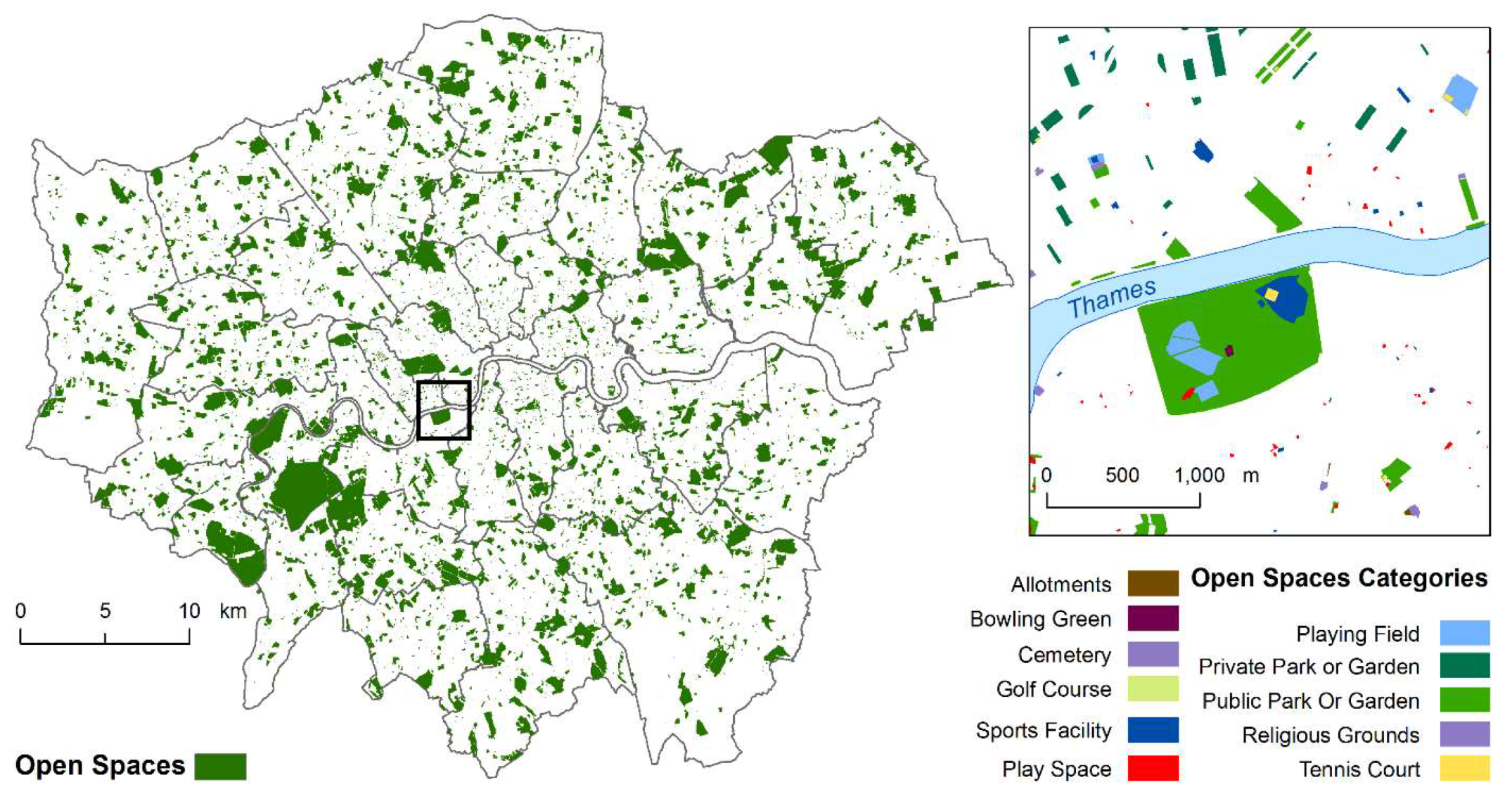
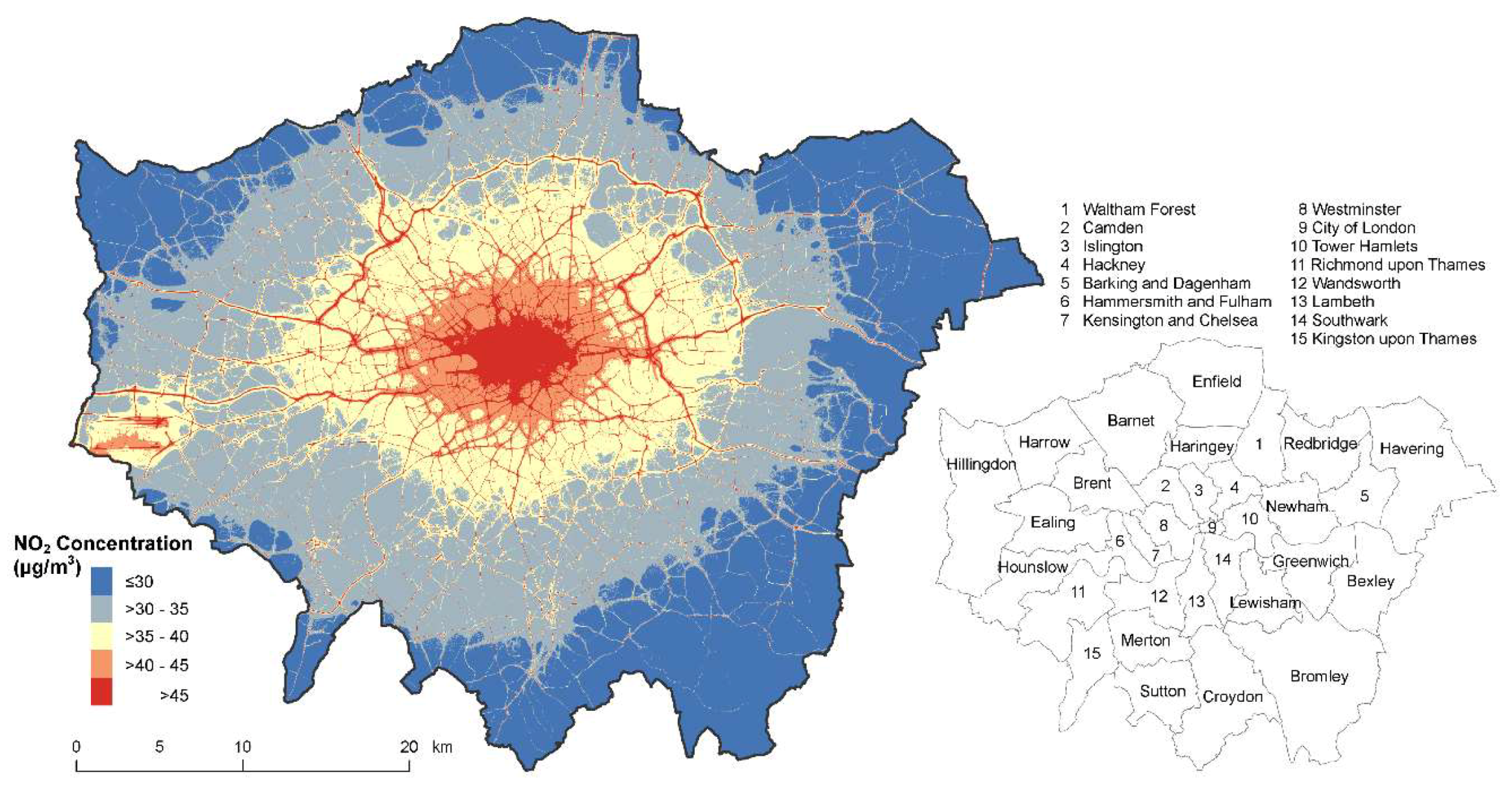
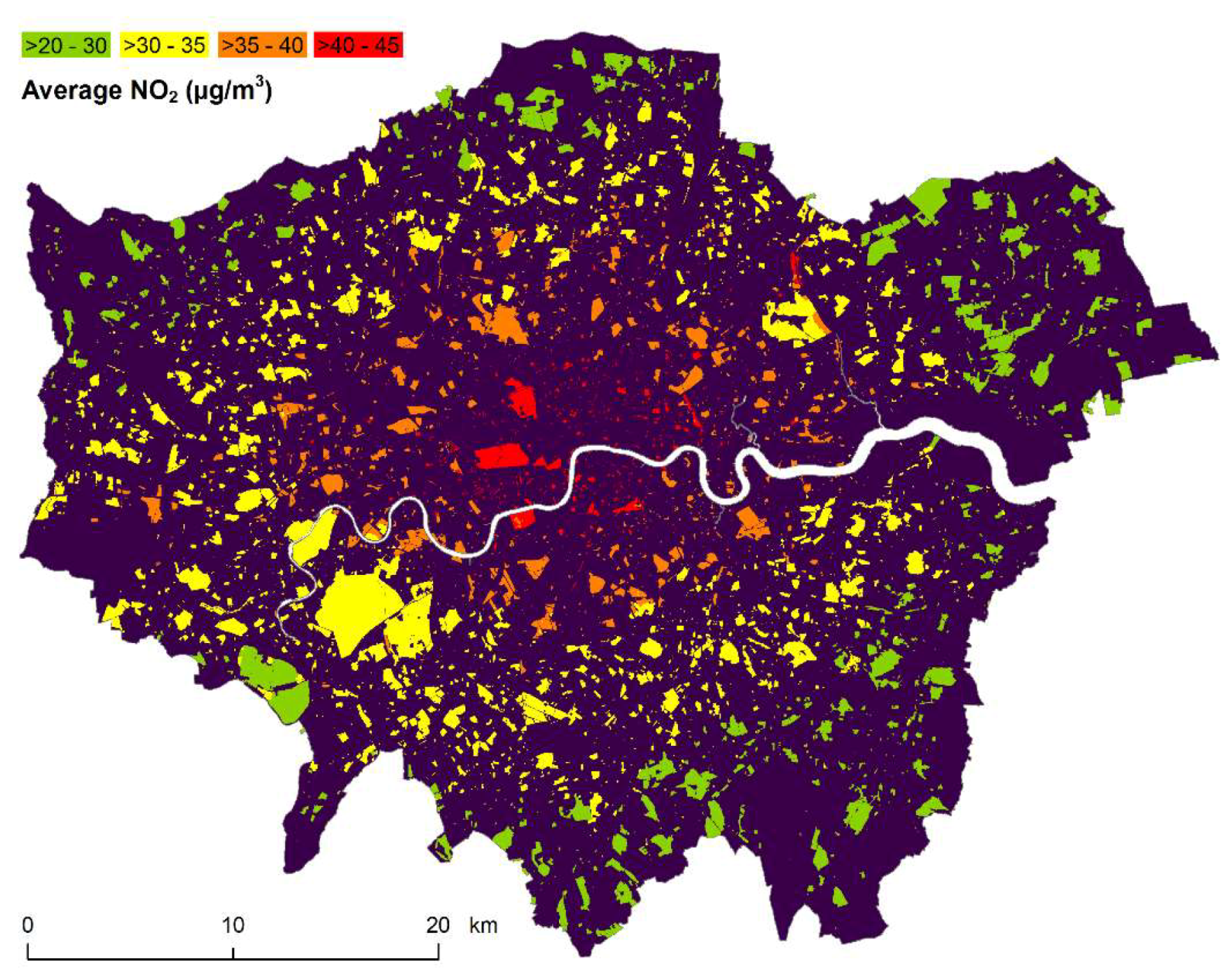
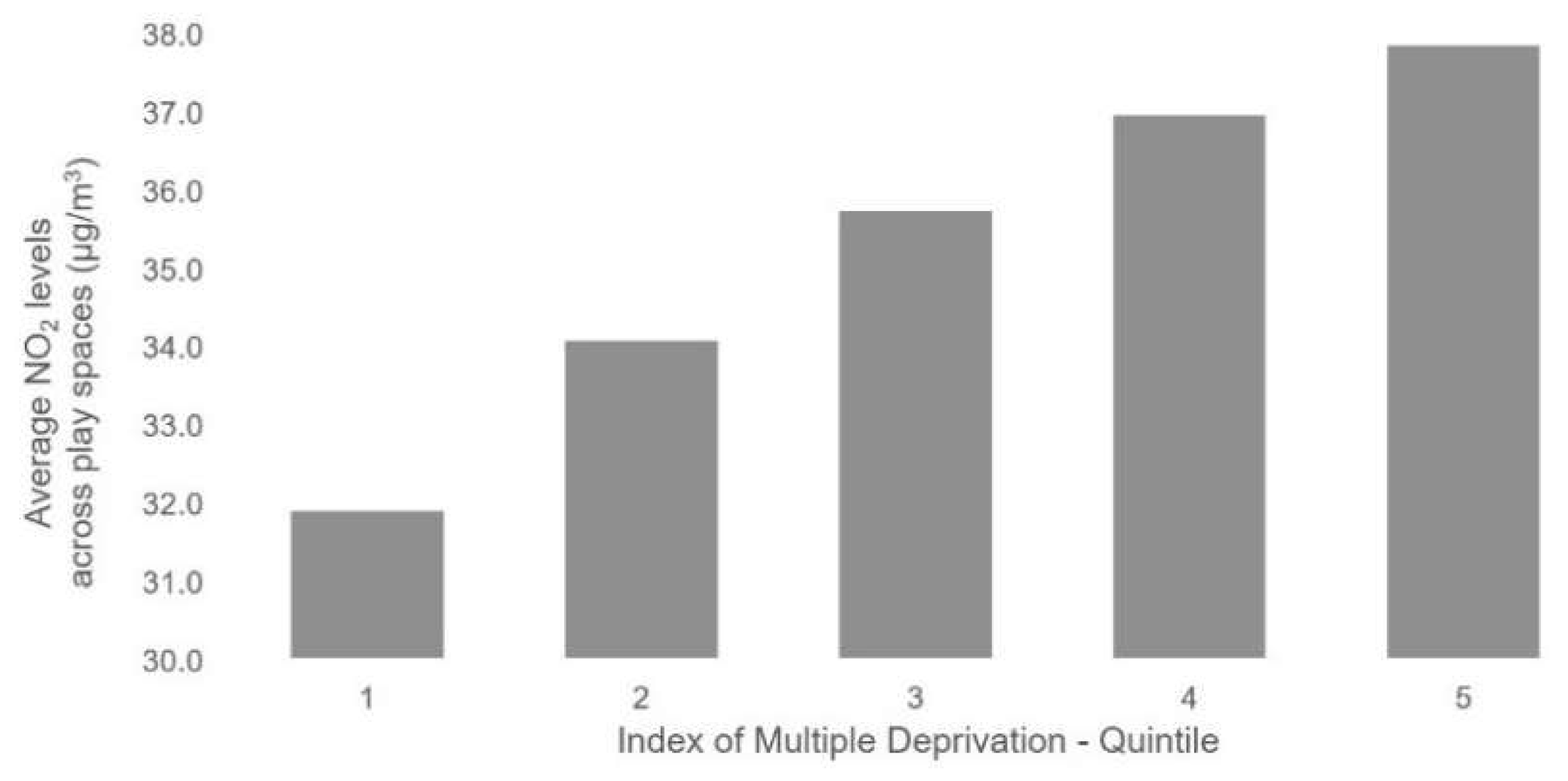
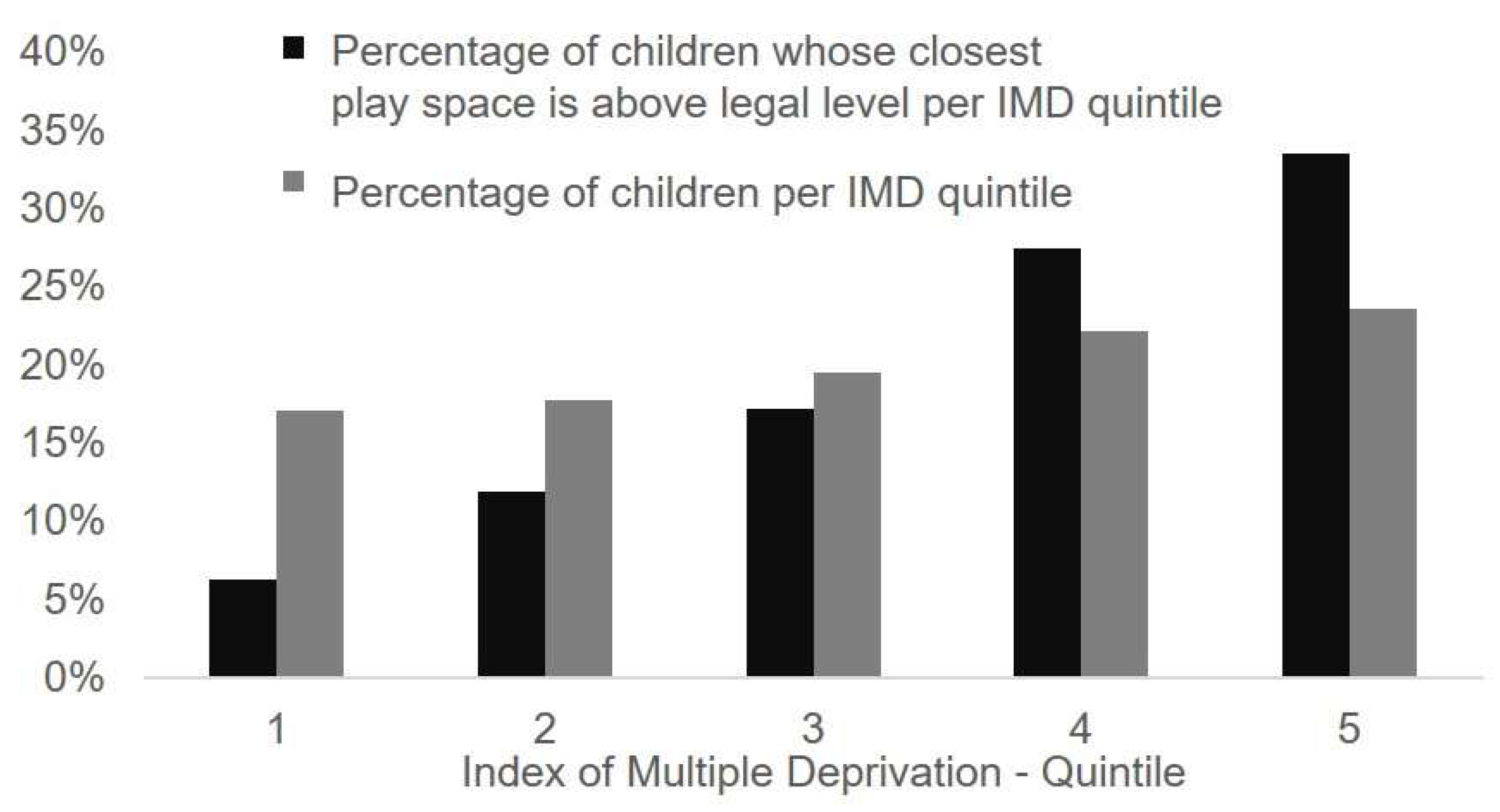
| Open Space Category | N | Average NO2 Concentration (µg/m3) | Percentage of Open Spaces with NO2 > 40 µg/m3 | ||||
|---|---|---|---|---|---|---|---|
| Mean | Min | Max | Average NO2 > 40 µg/m3 | 100% Area >40 µg/m3 | >1% Area >40 µg/m3 | ||
| Allotment | 769 | 33.0 | 23.9 | 45.9 | 4% | 4% | 9% |
| Bowling Green | 301 | 32.8 | 24.4 | 44.9 | 2% | 2% | 4% |
| Cemetery | 209 | 34.4 | 24.2 | 56.3 | 12% | 9% | 33% |
| Golf Course | 131 | 30.2 | 22.7 | 46.7 | 2% | 2% | 24% |
| Sports Facility | 1524 | 35.3 | 23.5 | 66.0 | 18% | 17% | 24% |
| Play Space | 3177 | 36.3 | 23.3 | 64.3 | 24% | 24% | 25% |
| Playing Field | 738 | 32.1 | 23.3 | 46.2 | 3% | 2% | 14% |
| Private Park or Garden | 153 | 40.5 | 27.6 | 57.7 | 67% | 65% | 78% |
| Public Park or Garden | 140 | 36.4 | 24.3 | 59.8 | 27% | 23% | 46% |
| Religious Ground | 802 | 34.6 | 23.6 | 53.2 | 13% | 10% | 21% |
| Tennis Court | 1000 | 33.4 | 23.4 | 52.5 | 6% | 6% | 7% |
| Borough | Play Spaces | Private Parks and Gardens | Public Parks and Gardens | |||
|---|---|---|---|---|---|---|
| Average NO2 (µg/m3) | % Spaces > 40 µg/m3 | Average NO2 (µg/m3) | % Spaces > 40 µg/m3 | Average NO2 (µg/m3) | % Spaces > 40 µg/m3 | |
| City of London * | 45.3 † | 100 | 53.7 † | 100 | 50.1 † | 100 |
| Westminster * | 44.0 † | 96 | 46.4 † | 100 | 47.3 † | 98 |
| Camden * | 42.1 † | 72 | 42.4 † | 50 | 43.7 † | 80 |
| Kensington and Chelsea * | 41.5 † | 72 | 42.1 † | 93 | 42.6 † | 87 |
| Islington * | 41.3 † | 66 | - | - | 42.6 † | 76 |
| Southwark * | 41.1 † | 64 | - | - | 41.4 † | 57 |
| Tower Hamlets * | 41.1 † | 69 | 41.8 † | 71 | 42.5 † | 79 |
| Lambeth * | 40.0 † | 45 | 42.8 † | 67 | 42.2 † | 64 |
| Hackney * | 39.5 | 35 | - | - | 40.4 † | 56 |
| Hammersmith and Fulham * | 39.5 | 26 | - | - | 40.0 | 32 |
| Wandsworth * | 37.3 | 16 | 37.2 | 0 | 38.9 | 13 |
| Newham | 37.0 | 5 | 36.9 | 0 | 36.3 | 0 |
| Brent | 36.8 | 14 | 32.3 | 0 | 35.5 | 0 |
| Haringey | 36.3 | 3 | - | - | 37.5 | 15 |
| Lewisham * | 35.6 | 5 | 36.5 | 0 | 35.8 | 5 |
| Ealing | 34.9 | 3 | 35.5 | 0 | 36.7 | 17 |
| Greenwich * | 34.8 | 3 | - | - | 34.0 | 3 |
| Waltham Forest | 34.8 | 4 | 34.2 | 0 | 36.4 | 15 |
| Hounslow | 34.3 | 4 | 33.6 | 0 | 35.2 | 7 |
| Barnet | 34.0 | 4 | - | - | 33.6 | 8 |
| Merton | 33.1 | 0 | 33.0 | 0 | 34.1 | 7 |
| Barking and Dagenham | 33.0 | 0 | - | - | 31.5 | 0 |
| Richmond upon Thames | 32.7 | 1 | 31.9 | 0 | 33.5 | 0 |
| Redbridge | 32.7 | 5 | - | - | 33.9 | 13 |
| Enfield | 32.4 | 0 | 28.6 | 0 | 33.1 | 2 |
| Kingston upon Thames | 31.9 | 0 | 31.9 | 0 | 32.8 | 0 |
| Hillington | 31.2 | 0 | 33.2 | 0 | 31.2 | 0 |
| Croydon | 30.9 | 0 | - | - | 30.4 | 0 |
| Sutton | 30.5 | 0 | - | - | 31.1 | 0 |
| Harrow | 30.5 | 0 | - | - | 31.0 | 0 |
| Bexley | 29.8 | 0 | - | - | 30.1 | 0 |
| Bromley | 28.6 | 0 | 29.9 | 0 | 29.5 | 2 |
| Havering | 27.7 | 0 | - | - | 27.0 | 0 |
© 2019 by the authors. Licensee MDPI, Basel, Switzerland. This article is an open access article distributed under the terms and conditions of the Creative Commons Attribution (CC BY) license (http://creativecommons.org/licenses/by/4.0/).
Share and Cite
Sheridan, C.E.; Roscoe, C.J.; Gulliver, J.; de Preux, L.; Fecht, D. Inequalities in Exposure to Nitrogen Dioxide in Parks and Playgrounds in Greater London. Int. J. Environ. Res. Public Health 2019, 16, 3194. https://doi.org/10.3390/ijerph16173194
Sheridan CE, Roscoe CJ, Gulliver J, de Preux L, Fecht D. Inequalities in Exposure to Nitrogen Dioxide in Parks and Playgrounds in Greater London. International Journal of Environmental Research and Public Health. 2019; 16(17):3194. https://doi.org/10.3390/ijerph16173194
Chicago/Turabian StyleSheridan, Charlotte E., Charlotte J. Roscoe, John Gulliver, Laure de Preux, and Daniela Fecht. 2019. "Inequalities in Exposure to Nitrogen Dioxide in Parks and Playgrounds in Greater London" International Journal of Environmental Research and Public Health 16, no. 17: 3194. https://doi.org/10.3390/ijerph16173194
APA StyleSheridan, C. E., Roscoe, C. J., Gulliver, J., de Preux, L., & Fecht, D. (2019). Inequalities in Exposure to Nitrogen Dioxide in Parks and Playgrounds in Greater London. International Journal of Environmental Research and Public Health, 16(17), 3194. https://doi.org/10.3390/ijerph16173194





